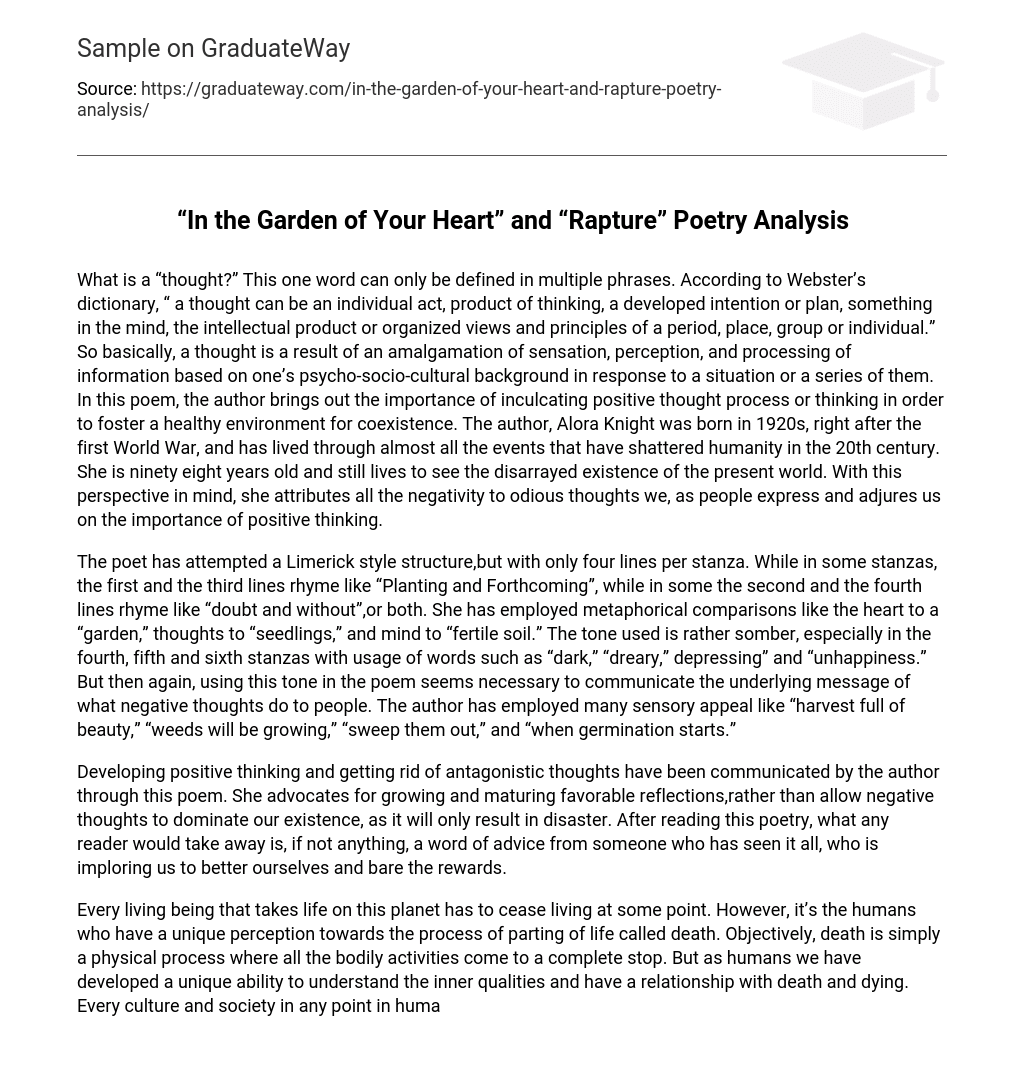What is a “thought?” This one word can only be defined in multiple phrases. According to Webster’s dictionary, “ a thought can be an individual act, product of thinking, a developed intention or plan, something in the mind, the intellectual product or organized views and principles of a period, place, group or individual.” So basically, a thought is a result of an amalgamation of sensation, perception, and processing of information based on one’s psycho-socio-cultural background in response to a situation or a series of them. In this poem, the author brings out the importance of inculcating positive thought process or thinking in order to foster a healthy environment for coexistence. The author, Alora Knight was born in 1920s, right after the first World War, and has lived through almost all the events that have shattered humanity in the 20th century. She is ninety eight years old and still lives to see the disarrayed existence of the present world. With this perspective in mind, she attributes all the negativity to odious thoughts we, as people express and adjures us on the importance of positive thinking.
The poet has attempted a Limerick style structure,but with only four lines per stanza. While in some stanzas, the first and the third lines rhyme like “Planting and Forthcoming”, while in some the second and the fourth lines rhyme like “doubt and without”,or both. She has employed metaphorical comparisons like the heart to a “garden,” thoughts to “seedlings,” and mind to “fertile soil.” The tone used is rather somber, especially in the fourth, fifth and sixth stanzas with usage of words such as “dark,” “dreary,” depressing” and “unhappiness.” But then again, using this tone in the poem seems necessary to communicate the underlying message of what negative thoughts do to people. The author has employed many sensory appeal like “harvest full of beauty,” “weeds will be growing,” “sweep them out,” and “when germination starts.”
Developing positive thinking and getting rid of antagonistic thoughts have been communicated by the author through this poem. She advocates for growing and maturing favorable reflections,rather than allow negative thoughts to dominate our existence, as it will only result in disaster. After reading this poetry, what any reader would take away is, if not anything, a word of advice from someone who has seen it all, who is imploring us to better ourselves and bare the rewards.
Every living being that takes life on this planet has to cease living at some point. However, it’s the humans who have a unique perception towards the process of parting of life called death. Objectively, death is simply a physical process where all the bodily activities come to a complete stop. But as humans we have developed a unique ability to understand the inner qualities and have a relationship with death and dying. Every culture and society in any point in human history have had their own interpretation and understanding of this biological process and have developed traditions to embrace this process. In this poem, the narrator walks us through his/her experience of what happens just before death occurs. The narrator chronicles the smooth transition of how life leaves the body, the last thoughts and the subjective response to the situation.
The poem is written as a free verse, but also has lyrical components to it. The narration is internal designed for first person monologue. The narrator relates to the theme by giving connotations like”characters have to leave one room and enter another,” meaning once you finish playing your part, you exit the scene. “History comes to head when in the time of the disaster,” meaning one dies and becomes history. The narrator makes use of symbols to describe the state of mind, like raptor, as in a bird of prey, namely Hawk, that circles around the dead and symbolic word like rapture, meaning one entering heaven. The poem is rich in imagery through out. ‘Events happen in the dark,’ “night club,” Grainy black and white,” and “costumes women wear,” are all examples of visual imagery, while “voice over,” “where wind is taking it,” are auditory and sense of touch respectively. Reference to Bill Evans, the famous pianist and Lauren Bacall famous for her voice are included as part of the setting at a nightclub. The entire scene gives the reader a sense that it is occuring in dim lights, or black and white, but in the end, it happens to be an afternoon.
Although, the mood of the poem is morbid, it renders an acceptance of the inevitable, looking toward the moment, waiting for the raptor. This aspect of the poem touches the readers in ways that many may not want to be touched. No one has lived to tell the story of what we see or feel while dying hence this poem is one way to understand what may happen at the end time, dark, dreary, a sense of calm that takes over.





